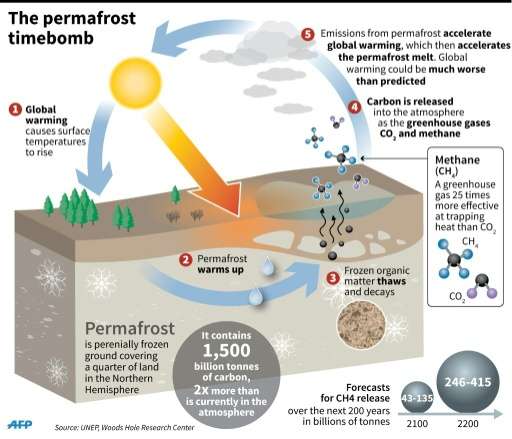Ahmedabad
(Head Office)Address : 506, 3rd EYE THREE (III), Opp. Induben Khakhrawala, Girish Cold Drink Cross Road, CG Road, Navrangpura, Ahmedabad, 380009.
Mobile : 8469231587 / 9586028957
Telephone : 079-40098991
E-mail: dics.upsc@gmail.com

Permafrost Thawing
News: According to the latest IPCC report, increasing global warming will result in reductions in Arctic permafrost and the thawing of the ground is expected to release greenhouse gases like methane and carbon dioxide.
What is Permafrost?
• ‘Permafrost’ or permanently frozen ground is land that has been frozen at or below 0 degrees Celsius for two or more consecutive years.
• A staggering 17 per cent of Earth’s entire exposed land surface is comprised of permafrost.
• Composed of rock, sediments, dead plant and animal matter, soil, and varying degrees of ice, permafrost is mainly found near the poles, covering parts of Greenland, Alaska, Northern Canada, Siberia and Scandinavia.
• The Arctic region is a vast ocean, covered by thick ice on the surface (called sea ice), surrounded by land masses that are also covered with snow and ice.
• When the permafrost was formed thousands of years ago, there weren’t many humans who lived in that region which was necessarily very cold.
• Researchers recently found mammoths in the permafrost in Russia. And some of these mammoth carcasses when they begin to degrade again may reveal bacteria that were frozen thousands of years ago.
• So, there will be surprises. But whether they will be lethal surprises is just not possible to say.
.jpg)
Permafrost thawing
• When permafrost thaws, water from the melted ice makes its way to the caves along with ground sediments, and deposits on the rocks.
• In other words, when permafrost thaws, the rocks grow and when permafrost is stable and frozen, they do not grow.
Concerns:
• It will affect countries where roads or buildings were constructed on permafrost.
• It entombed and froze the organic material in the ground. If the ground begins to thaw, this material will become available for microorganisms to break down.
• In some environments, the microorganisms will release carbon dioxide, and in others release methane which is about 25 to 30 times more potent as a greenhouse gas than carbon dioxide. Some permafrost regions have changed from being a carbon storehouse to being places that are net emitters of carbon.
• This year Russia witnessed a forest fire whose total area was the size of Portugal. Usually, after a fire, one expects the forest to grow back in the next 50 years to 60 years. This restores the carbon stock in the ecosystem.
• But in the tundra, the peat is where the organic material is and this takes a very long time to accumulate. So if peat is burned and released into the atmosphere, then it will take centuries to restore that carbon stock at ground level.
• The environment now is so much more suitable than during the Ice Age for not just human life, but also the evolution or development of viruses and bacteria. So, the chances of emerging new bacteria or viruses cannot be ignored.

Address : 506, 3rd EYE THREE (III), Opp. Induben Khakhrawala, Girish Cold Drink Cross Road, CG Road, Navrangpura, Ahmedabad, 380009.
Mobile : 8469231587 / 9586028957
Telephone : 079-40098991
E-mail: dics.upsc@gmail.com
Address: A-306, The Landmark, Urjanagar-1, Opp. Spicy Street, Kudasan – Por Road, Kudasan, Gandhinagar – 382421
Mobile : 9723832444 / 9723932444
E-mail: dics.gnagar@gmail.com
Address: 2nd Floor, 9 Shivali Society, L&T Circle, opp. Ratri Bazar, Karelibaugh, Vadodara, 390018
Mobile : 9725692037 / 9725692054
E-mail: dics.vadodara@gmail.com
Address: 403, Raj Victoria, Opp. Pal Walkway, Near Galaxy Circle, Pal, Surat-394510
Mobile : 8401031583 / 8401031587
E-mail: dics.surat@gmail.com
Address: 303,305 K 158 Complex Above Magson, Sindhubhavan Road Ahmedabad-380059
Mobile : 9974751177 / 8469231587
E-mail: dicssbr@gmail.com
Address: 57/17, 2nd Floor, Old Rajinder Nagar Market, Bada Bazaar Marg, Delhi-60
Mobile : 9104830862 / 9104830865
E-mail: dics.newdelhi@gmail.com